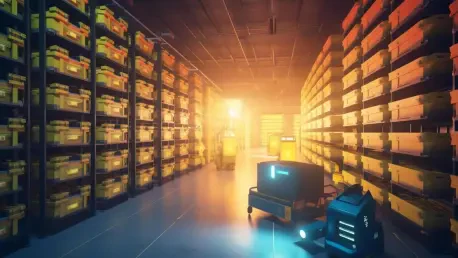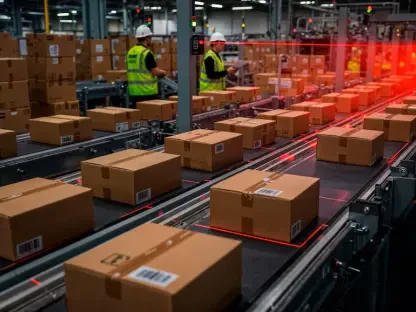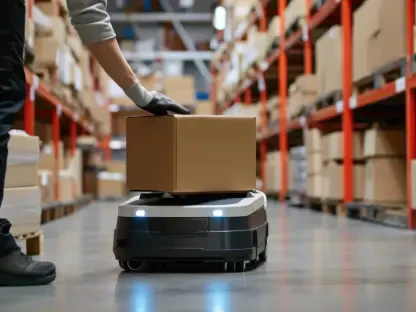In today’s logistics landscape, technological advancements are revolutionizing traditional systems to meet the demands of ever-changing industry needs. Rohit Laila, an expert with extensive experience in supply chain and delivery, joins us to delve into the groundbreaking innovations of the Celluveyor system. With a passion for technology, Rohit provides insights into how these innovations are transforming warehouse logistics.
What are the main features of the Celluveyor system, and how does it operate in warehouse settings?
The Celluveyor system is quite a marvel of modern logistics technology. It consists of modular hexagonal cells equipped with omniwheels that facilitate precise movement in any direction. This allows packages to be handled with the utmost flexibility and accuracy, even in the tightest warehouse spaces. The adaptable design means it can be easily integrated into existing operations and is an ideal alternative to traditional conveyor belts.
What inspired Cellumation to develop this technology using hexagonal cells and omniwheels?
The inspiration behind the Celluveyor technology stemmed from a desire to innovate beyond traditional constraints. Using hexagonal cells creates a compact, space-efficient structure that fits effortlessly into complex warehouse environments. The omniwheel technology was chosen for its ability to maneuver objects with precision, akin to how autonomous vehicles navigate, but on a micro scale within logistics operations.
In what ways do the 360° omniwheels enhance the efficiency and safety of the Celluveyor system?
The 360° omniwheels are fundamental to the system’s efficiency and safety. Each wheel can be individually controlled, allowing seamless and collision-free movement. This ensures packages are transported safely without disruptions, enhancing operational safety and improving throughput by optimizing package flow even through tight spaces.
Can you explain the role of AI and the vision system in the operation of the Celluveyor?
AI plays a crucial role by utilizing a sophisticated 3D camera-based vision system that continuously monitors each package’s height, size, and position. This data is processed to optimize routing in real-time, ensuring efficient handling with minimal human intervention. The vision system provides the necessary inputs for AI algorithms that control movement paths, streamlining operations remarkably.
How is the Celluveyor system advantageous compared to traditional conveyor belts in confined warehouse spaces?
Traditional conveyor belts often struggle with space adaptability, but the Celluveyor’s compact, modular architecture excels in cramped environments. It allows for precise movements without heavy infrastructure changes, saving valuable floor space and offering greater scalability and flexibility. This is particularly beneficial for modern warehouses that need to continuously adapt to varying logistics demands.
What specific challenges in warehouse logistics does the Celluveyor address?
The Celluveyor system addresses several critical challenges, including space constraints, efficient routing, and precise package handling. Its modular design significantly reduces the need for expansive setups, while AI-driven automation ensures optimal routing, lowering the margin for error and enhancing overall operational efficiency.
How does the collaboration between Cellumation and Daifuku enhance the Celluveyor’s capabilities?
Partnering with Daifuku integrates the Celluveyor with advanced robotic depalletization, extending its capabilities beyond simple package movement. This collaboration facilitates seamless integration with sophisticated robotic systems, enhancing overall logistics efficiency and ensuring the Celluveyor is part of a comprehensive warehouse automation solution.
What led to the strategic partnership with Daifuku for integrating the Celluveyor in robotic depalletization?
The partnership with Daifuku was driven by a mutual goal to push boundaries in logistics automation. Integrating Celluveyor technology into robotic depalletization appealed to both entities due to its potential to streamline processes, enhance precision, and deliver improved throughput, which are essential in meeting contemporary distribution challenges.
How does the descrambling device powered by Celluveyor technology function in warehouse operations?
The Celluveyor descrambler functions as a critical component in sorting packages. Driven by AI software, it operates within a small footprint, efficiently organizing items and minimizing the area needed for processing layers. This capability significantly enhances sorting and processing speed, making it indispensable for high-volume warehouse operations.
How does the Celluveyor descrambler contribute to space-saving measures in warehouses?
Its less than 3 m² footprint is where its utility shines. By minimizing the space required for descrambling, it allows warehouses to maximize floor space, which is often a scarce resource. The efficiency of handling large volumes without sprawling infrastructures greatly optimizes spatial management.
In what way does the open structure of the Celluveyor allow for adaptability and reconfiguration in different tasks?
The open structure is a key feature that facilitates rapid adaptation to changing roles within warehouses. This means the system can be reconfigured for various tasks without major overhauls, allowing logistics operations to pivot swiftly and efficiently in response to evolving business requirements.
What makes the Celluveyor system suitable for e-commerce fulfillment centers and managing a wide range of SKUs?
Its ability to handle diverse package types efficiently makes the Celluveyor ideal for e-commerce centers which often deal with a large assortment of SKUs. The system’s real-time adaptability ensures accurate sorting and handling across different product categories, catering excellently to the dynamic needs of e-commerce logistics.
Can you discuss the use of digital twins with the Celluveyor to enhance efficiency?
Digital twins represent a forward-thinking application in logistics. They allow for virtual simulations and optimizations post-installation, enabling enhancements to be made without physical alterations. This can drive operational efficiencies significantly, as it provides a robust platform for continuous improvement and scalability without downtime.
What are the potential benefits of integrating the Celluveyor with Daifuku’s warehouse automation package?
Integration with Daifuku’s automation package brings powerful data analytics and performance indicators, offering deep insights into operations. This enables systematic improvements and better decision-making, transforming how logistics are managed through enhanced visibility and control over the entire process.
How does the system ensure precise and collision-free movement of packages?
The system is meticulously engineered with AI and a vision system that anticipates potential issues and reroutes packages to prevent collisions. This precision eliminates bottlenecks and ensures smooth operations, enhancing both efficiency and safety throughout the process.
What are the expected throughput levels of the Celluveyor system?
The Celluveyor system offers impressive throughput, capable of processing up to 450 layers or 5,200 packages per hour. Such capacity underlines its efficiency and suitability for large-scale operations, showcasing its ability to meet industrial demands effectively.
How do the advanced vision system and robotic arm reduce the need for human intervention?
The vision system, coupled with robotic technology, automates intricate tasks such as package sorting and alignment, drastically cutting down manual oversight. This fosters a highly autonomous environment where human involvement is limited to supervisory roles rather than routine tasks.
What performance indicators and analytics can users access with Daifuku’s automation package integration?
Users can benefit from comprehensive performance indicators covering throughput, efficiency, and operational metrics. Advanced analytics provide actionable insights, helping pinpoint areas of improvement and ensuring optimal functioning of logistics processes.
How does Cellumation plan to expand its market share in the US through its partnership with Daifuku?
By leveraging Daifuku’s extensive market presence and reputation in automation, Cellumation aims to penetrate the US market robustly. The partnership empowers them to present the Celluveyor as a leader in innovative logistics solutions, tapping into advanced strategic opportunities.
Can you share any upcoming updates or enhancements planned for the Celluveyor system?
Cellumation is constantly refining the Celluveyor to meet evolving demands, with plans for software updates that enhance operational capabilities. Future enhancements focus on integrating smarter algorithms, improving adaptability, and extending its application to a wider range of industries.
Do you have any advice for our readers?
As automation reshapes logistics, staying informed and adaptable is key. Embrace innovation and consider how integrating smart solutions can elevate your operational capabilities, ensuring you remain competitive in an increasingly complex environment.








